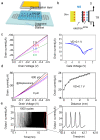Highly Stretchable Graphene Scrolls Transistors for Self-Powered Tribotronic Non-Mechanosensation Application
- PMID: 36770490
- PMCID: PMC9920215
- DOI: 10.3390/nano13030528
Highly Stretchable Graphene Scrolls Transistors for Self-Powered Tribotronic Non-Mechanosensation Application
Abstract
Owing to highly desired requirements in advanced disease diagnosis, therapy, and health monitoring, noncontact mechanosensation active matrix has drawn considerable attention. To satisfy the practical demands of high energy efficiency, in this report, combining the advantage of multiparameter monitoring, high sensitivity, and high resolution of active matrix field-effect transistor (FET) with triboelectric nanogenerators (TENG), we successfully developed the tribotronic mechanosensation active matrix based on tribotronic ion gel graphene scrolls field-effect transistors (GSFET). The tribopotential produced by TENG served as a gate voltage to modulate carrier transport along the semiconductor channel and realized self-powered ability with considerable decreased energy consumption. To achieve high spatial utilization and more pronounced responsivity of the dielectric of this transistor, ion gel was used to act as a triboelectric layer to conduct friction and contact electrification with external materials directly to produce triboelectric charges to power GFET. This tribopotential-driving device has excellent tactile sensing properties with high sensitivity (1.125 mm-1), rapid response time (~16 ms), and a durability operation of thousands of cycles. Furthermore, the device was transparent and flexible with the capability of spatially mapping touch stimuli and monitoring real-time temperature. Due to all these unique characteristics, this novel noncontact mechanosensation GSFET active matrix provided a new method for self-powered E-skin with promising potential for self-powered wearable devices and intelligent robots.
Keywords: graphene scrolls; ion gel; mechanosensation; tribotronic.
Conflict of interest statement
The authors declare no competing financial interest.
Figures





References
-
- Chen J.W., Zhu Y.T., Chang X.H., Pan D., Song G., Guo Z.H., Naik N. Recent Progress in Essential Functions of Soft Electronic Skin. Adv. Funct. Mater. 2021;31:2104686. doi: 10.1002/adfm.202104686. - DOI
-
- Chortos A., Bao Z. Skin-Inspired Electronic Devices. Mater. Today. 2014;17:321–331. doi: 10.1016/j.mattod.2014.05.006. - DOI
LinkOut - more resources
Full Text Sources

